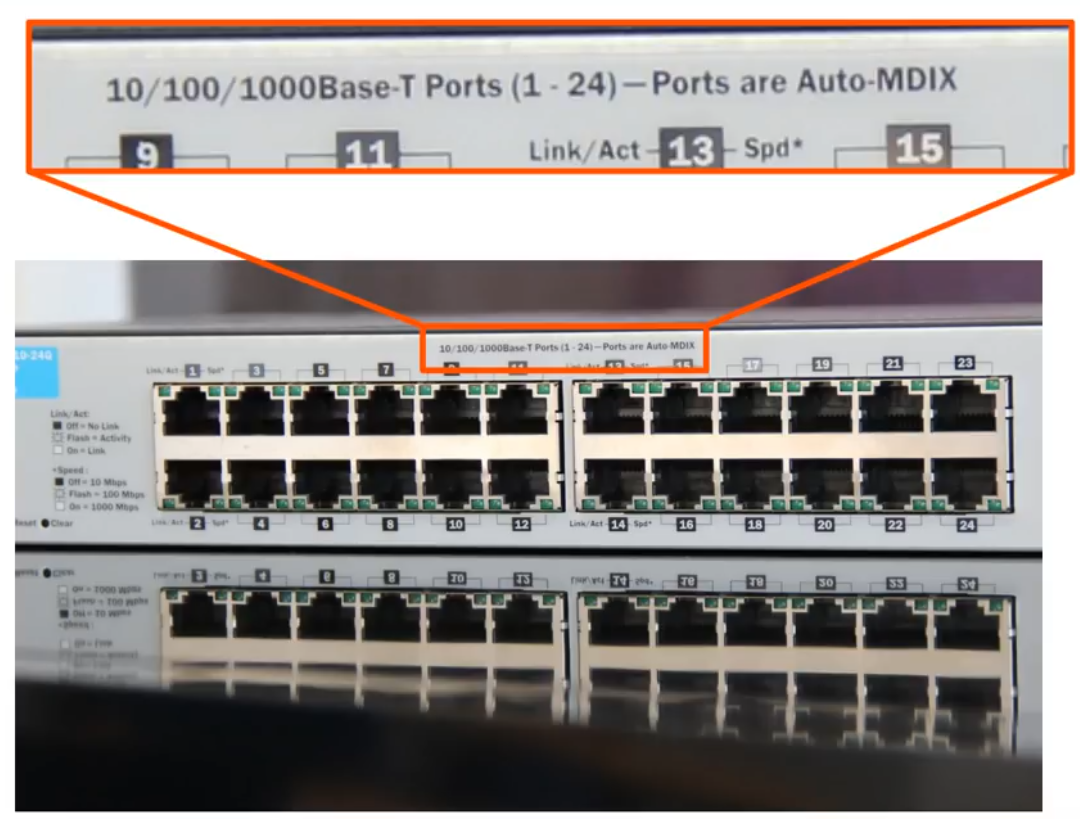Introduction to Switch Interfaces
Switches are critical components in networking, and a key feature of switches is their numerous interfaces or ports. In the image of a typical switch, you can observe multiple ports, commonly referred to by numbers such as 10/100/1000 Base-T. These labels define the speed and type of Ethernet supported by the ports.
What Do 10/100/1000 Base-T Mean?
- 10/100/1000 Base-T is a specification for Ethernet connections, which represents three different speeds:
- 10 Mbps (Megabits per second)
- 100 Mbps
- 1,000 Mbps or 1 Gbps (Gigabit per second)
This standard refers to Base-T, where Base indicates that the network uses baseband signaling (transmitting one signal type over the cable), and T refers to twisted-pair cabling. Twisted-pair cables are common in networks and consist of pairs of wires twisted together to reduce interference.
Auto MDI-X
Many switches, including those in the image, are equipped with Auto MDI-X capability. This feature automatically configures the cable settings, meaning you no longer need to worry about using specific crossover or straight-through cables for connecting devices.
RJ-45 Connectors and Ethernet Cables
The interfaces on most switches are RJ-45 ports. An RJ-45 (Registered Jack-45) connector is used with copper-based Ethernet cables, commonly seen in wired networks for connecting computers to switches or routers.
The Ethernet cables themselves can vary in terms of color and design but still feature the standard RJ-45 connector. These cables transmit data using copper wiring, but other types of Ethernet cables exist, including fiber optic versions (discussed in later sections).
Understanding Ethernet: Protocols and Standards
Ethernet is more than just a single protocol—it’s a collection of network protocols and standards. Ethernet defines how data is transmitted over physical media like copper cables. Its protocols ensure compatibility between network devices, allowing smooth communication between computers, switches, routers, and more.
For example, just as two people would need a common language to communicate, network devices rely on Ethernet standards to communicate efficiently, both physically (through connectors like RJ-45) and logically (through protocols like IP).
Network Speeds and Measurements
Network speed is commonly measured in bits per second (bps). However, it’s crucial to understand the difference between bits and bytes. Here’s a breakdown:
- Bit: The smallest unit of data, represented as 0 or 1.
- Byte: Eight bits form one byte.
- Speed units:
- 1 Kilobit (Kbps) = 1,000 bits per second
- 1 Megabit (Mbps) = 1,000,000 bits per second
- 1 Gigabit (Gbps) = 1,000,000,000 bits per second
- 1 Terabit (Tbps) = 1,000,000,000,000 bits per second
While bytes (e.g., GB) are used to measure storage, bits (e.g., Gbps) are used to measure network speed.
Ethernet Standards and Cabling
Ethernet standards are defined by the IEEE 802.3 working group. The most common standards include:
- 10Base-T: 10 Mbps over twisted-pair cabling.
- 100Base-T: 100 Mbps over twisted-pair cabling.
- 1000Base-T: 1 Gbps over twisted-pair cabling.
- 10GBase-T: 10 Gbps over twisted-pair cabling.
Each of these standards specifies the speed, type of cabling, and maximum distance for reliable transmission. For example, the maximum cable length for twisted-pair Ethernet cables is typically 100 meters.
Baseband Signaling and Twisted-Pair Cables
- Baseband signaling refers to transmitting data over a single signal channel on the cable.
- Twisted-pair cabling is used to reduce interference, making it ideal for Ethernet networks.
Why Network Protocols and Standards Matter
Just like the need for a common language between people, network protocols like Ethernet ensure that devices from different manufacturers can communicate without issues. Standards like the RJ-45 connector allow uniformity in hardware, while protocols like IP (Internet Protocol) ensure logical communication between devices across networks.
Conclusion
Understanding Ethernet and network interfaces is essential for anyone working in IT or preparing for certifications like CCNA. From recognizing the various Ethernet standards to understanding the role of RJ-45 connectors and twisted-pair cables, this foundational knowledge is critical for establishing reliable, efficient network connections.

